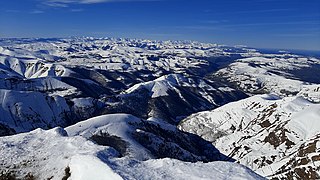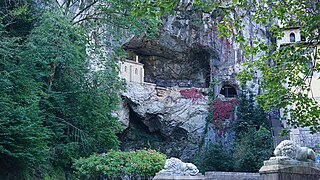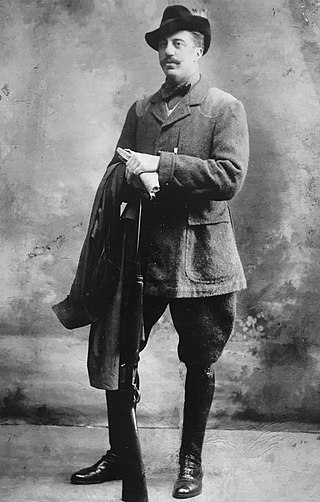Related Research Articles

The Kingdom of Asturias was a kingdom in the Iberian Peninsula founded by the Visigothic nobleman Pelagius. It was the first Christian political entity established after the Umayyad conquest of Visigothic Hispania in 711. In the Summer of 722, Pelagius defeated an Umayyad army at the Battle of Covadonga, in what is retroactively regarded as the beginning of the Reconquista.

Asturias officially the Principality of Asturias, is an autonomous community in northwest Spain.

Covadonga is one of 11 parishes in Cangas de Onís, a municipality within the province and autonomous community of Asturias, in Northwestern Spain. It is situated in the Picos de Europa mountains. With a permanent population of 55, the parish became a site of pilgrimage and a place of great cultural importance following the 722 Battle of Covadonga, which marked the beginning of the Spanish Reconquista of the Iberian Peninusla. The battle, which took place near the village in 722, was the first Christian victory in the Iberian Peninsula over the Arabs invading from north Africa under the Umayyad banner, and is often considered to be the beginning of the almost eight century-long effort to expel Muslim rulers governing Iberia during the Reconquista.

Charles Eugene Barrois was a French geologist and palaeontologist.

The Picos de Europa are a mountain range extending for about 20 km (12 mi), forming part of the Cantabrian Mountains in northern Spain. The range is situated in the Autonomous Communities of Asturias, Cantabria and Castile and León. The highest peak is Torre de Cerredo, at an elevation of 2650 m (8,690 ft).

Cabrales is a municipality in the autonomous community of Asturias, Spain. It is situated between the Sierra de Cuera and the Picos de Europa, and is a region famous for its Cabrales cheese. It is divided into nine parishes; Las Arenas is the largest, with a population 767 as of 2023. The population for the municipality as a whole sat at 1,918 as of 2023.

The Cantabrian Mountains or Cantabrian Range are one of the main systems of mountain ranges in Spain. They stretch for over 300 km (180 miles) across northern Spain, from the western limit of the Pyrenees to the Galician Massif in Galicia, along the coast of the Cantabrian Sea. Their easternmost end meets the Sistema Ibérico.

The Naranjo de Bulnes is a limestone peak dating from the Paleozoic Era, located in the Macizo Central region of the Picos de Europa, Asturias (Spain). Its name Picu Urriellu is believed to be derived from the term Los Urrieles, which is used to describe the Macizo Central. Naranjo de Bulnes is part of the Cabrales region of Asturias, and lies within the Picos de Europa National Park.

The Lakes of Covadonga (el. 1134 m.) are composed of two glacial lakes located on the region of Asturias, Spain. These lakes, often also called Lakes of Enol or simply Los Lagos, are Lake Enol and Lake Ercina located in the Picos de Europa range and they are the original center of the Picos de Europa National Park, created in 1918. They are near the Covadonga Sanctuary.

The Picos de Europa National Park is a National Park in the Picos de Europa mountain range, in northern Spain. It is within the boundaries of three autonomous communities, Asturias, Cantabria and Castile and León, which are represented on the body which runs the park. The park is also a popular destination for hikers and trekkers.

Liébana is a comarca of Cantabria (Spain). It covers 575 square kilometres and is located in the far southwest of Cantabria, bordering Asturias, León and Palencia. It is made up of the municipalities of: Cabezón de Liébana, Camaleño, Cillorigo de Liébana, Pesaguero, Potes, Tresviso and Vega de Liébana.

Louis François Élisabeth Ramond, baron de Carbonnières, was a French politician, geologist and botanist. He is regarded as one of the first explorers of the high mountains of the Pyrenees who can be described as a pyreneist.

The geology of the Iberian Peninsula consists of the study of the rock formations on the Iberian Peninsula, connected to the rest of the European landmass by the Pyrenees. The peninsula contains rocks from every geological period from the Ediacaran to the Quaternary, and many types of rock are represented. World-class mineral deposits are also found there.

Torre Cerredo, also called Torrecerredo or Torre de Cerredo, is the highest peak of the Cantabrian Mountains, northern Spain. With a prominence of 1,931 m, it is an ultra-prominent peak and the third most prominent peak of the Iberian Peninsula.

The Santa Cueva de Covadonga is a Catholic sanctuary located in Asturias, northern Spain. It is a cave in the Picos de Europa mountains, which gives its name to the parish of Covadonga in the municipality of Cangas de Onís. The name refers to the sanctuary, dedicated to the Virgin of Covadonga, where the first battle of the Reconquista took place in 718.

The Urrieles Massif or the Central Massif is a mountainous massif in the north of Spain, one of the three massifs that make up the Picos de Europa, and in turn, one of the stretches of the Cantabrian Massif belonging to the Cantabrian Range. The other two massifs are the Cornión and Ándara. Of the three, it is the tallest.

Lake Enol is a small highland lake in the Principality of Asturias, Spain. It is located in the Picos de Europa Western Massif, Cantabrian Mountains. It is next to Lake Ercina and together, they form the group known as Lakes of Covadonga, inside the Picos de Europa National Park. Lake Enol is the larger of the two. It is situated approximately 10 km from Covadonga and 25 km from Cangas de Onís. A curving road is available from Arriondas to the lake. Measuring 0.1 square kilometres (0.039 sq mi), it is one of the biggest lakes in the area. Lake Enol is situated 1,070 metres (3,510 ft) above sea level, in the Picos de Europa). It was formed by the withdrawal of a front glacier.
Sport in Asturias has always been dominated by football. Other popular sport activities include basketball, cycling, handball, volleyball, roller hockey, and rugby union. Asturias has also hosted a number of international events such as group stage games during the 1982 FIFA World Cup, series of the Davis Cup World Group, international roller hockey competitions, several cycling states of La Vuelta and several matches of the Spain national football team.

The Cantabrian mixed forests is a temperate broadleaf and mixed forests ecoregion in southwestern Europe. It extends along the coastal Cantabrian Mountains and Galician Massif of Northern Spain, extending south into northern Portugal, and northwards through the westernmost Pyrenees to southwestern France. The ecoregion extends from the seacoast to the highest peaks of the Cantabrian Mountains. The highest peak is Torre Cerredo at 2,648 meters elevation.

Pedro José Pidal y Bernaldo de Quirós, 1st Marquess of Villaviciosa de Asturias, MP was a Spanish peer, politician, mountaineer, writer, famed hunter and Olympic medalist. A visionary in the field of conservationism, he engineered the creation of Picos de Europa National Park in 1918 and was the first person to reach the summit of Naranjo de Bulnes, in 1904.
References
- ↑ J. Truyols Santoja, E. Martínez García y E. Villa Otero (2007). La ciencia perdida del Dr. Gustavo Schulze (PDF) (in Spanish). Universidad de Oviedo.
- ↑ Villa Otero, E., Martínez García, E., Truyols Santonja, J. & Schulze Christalle, P (2006). Gustav Schulze en los Picos de Europa. Caja Astur, Oviedo, 293 p.